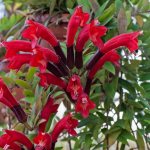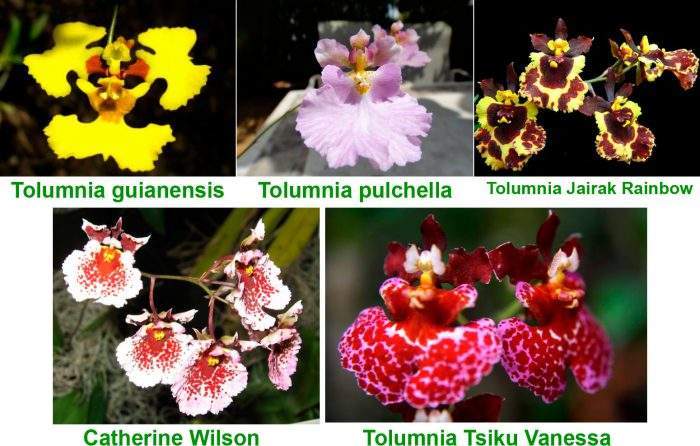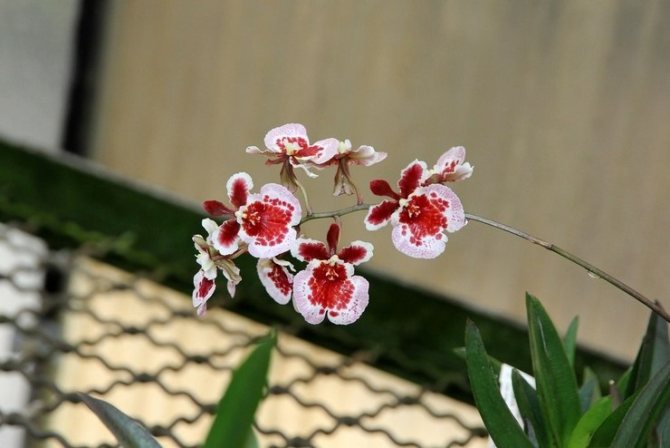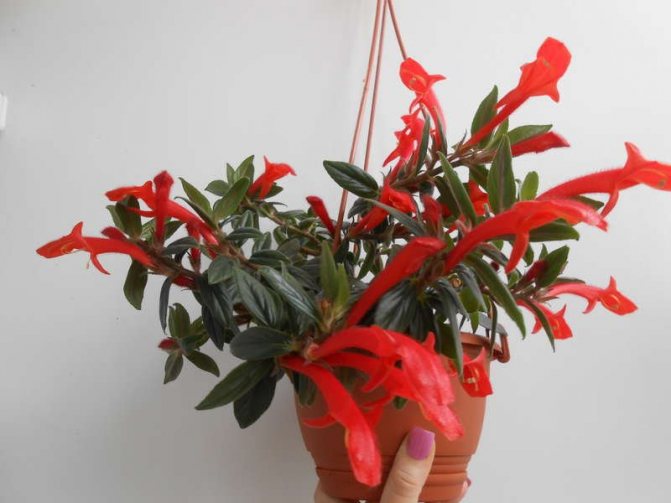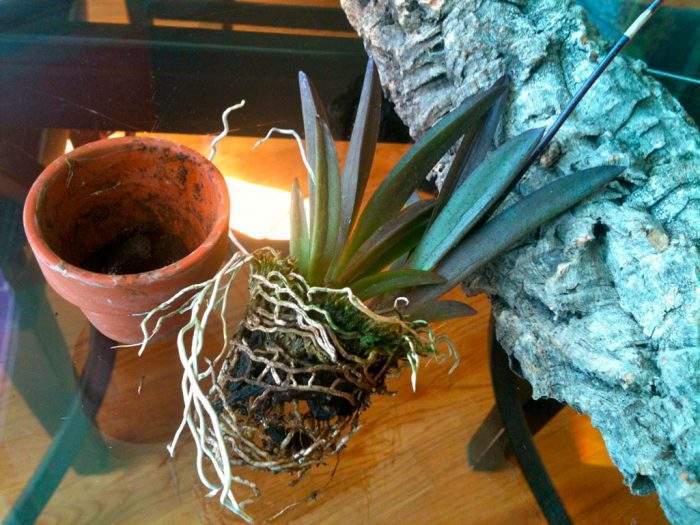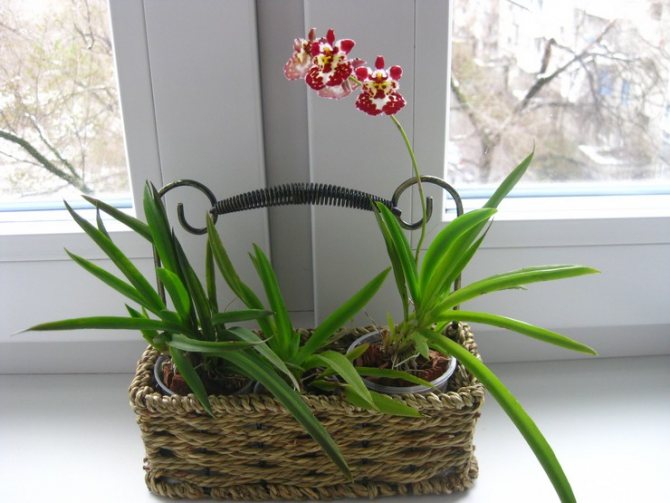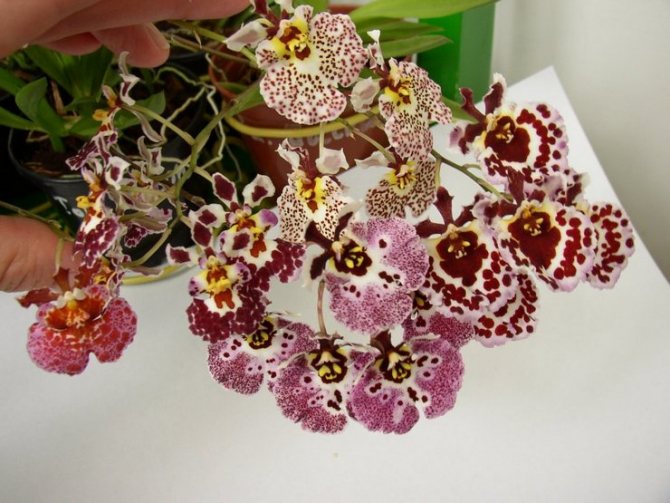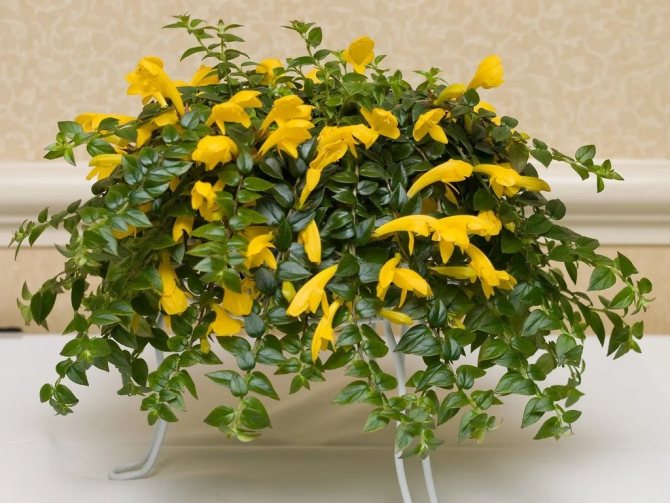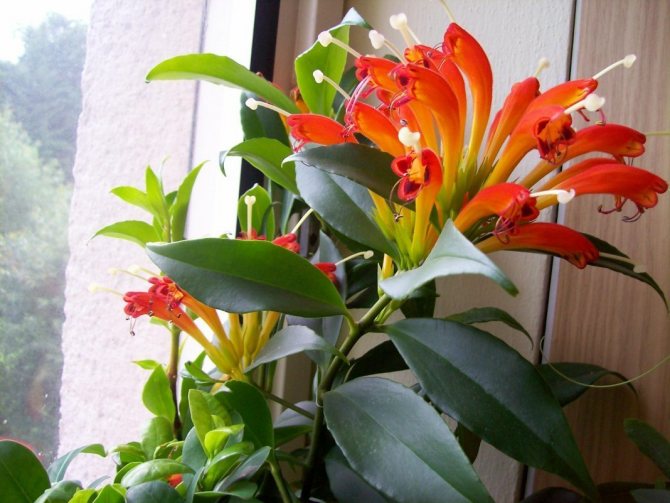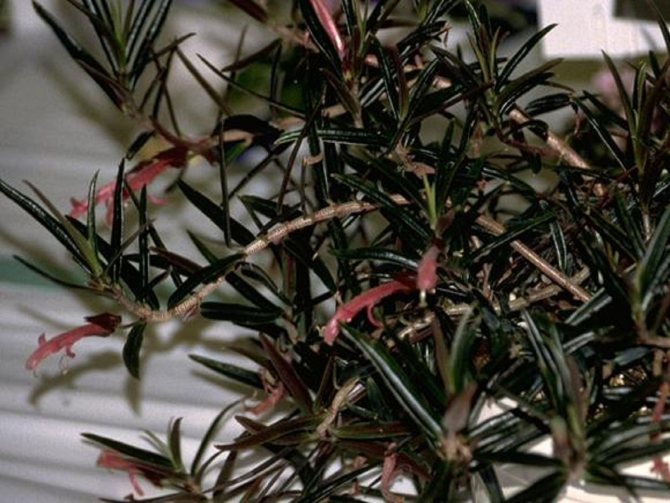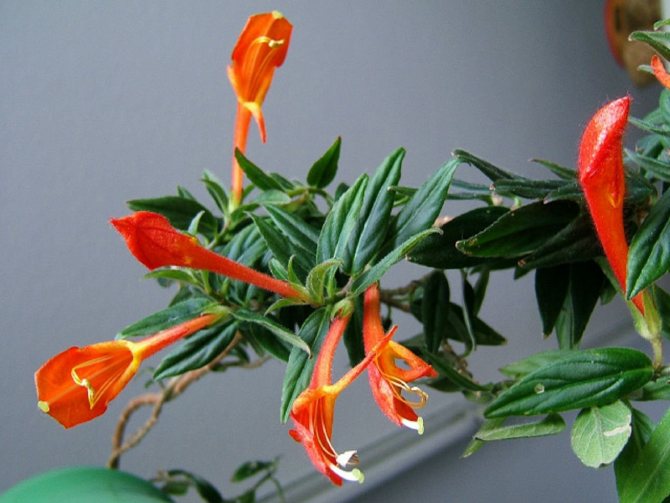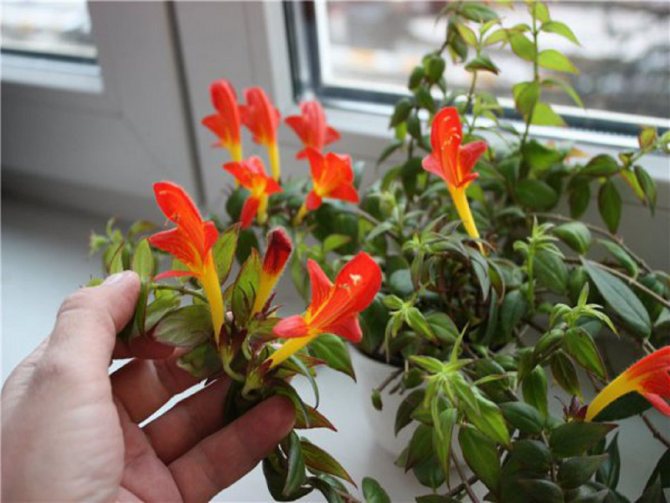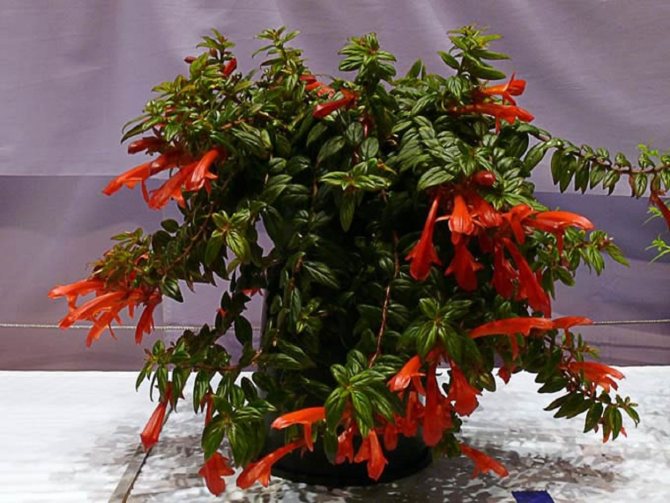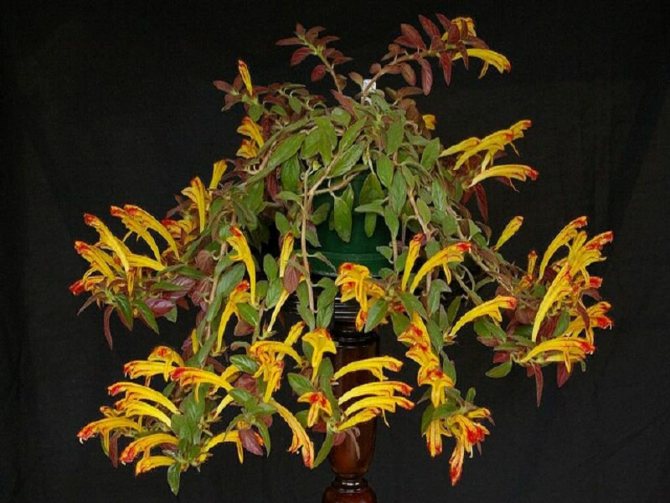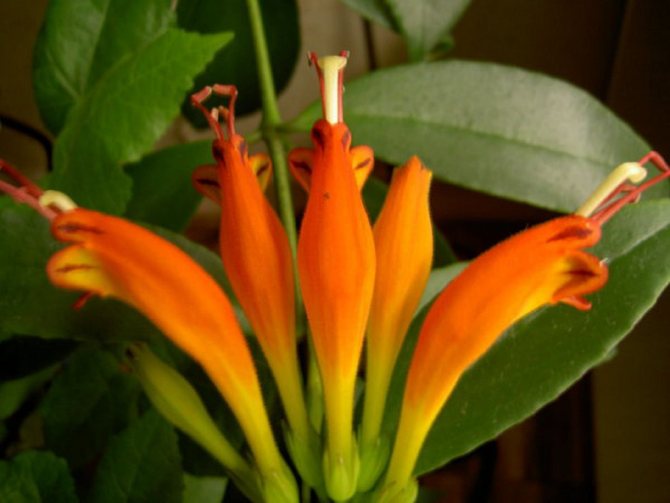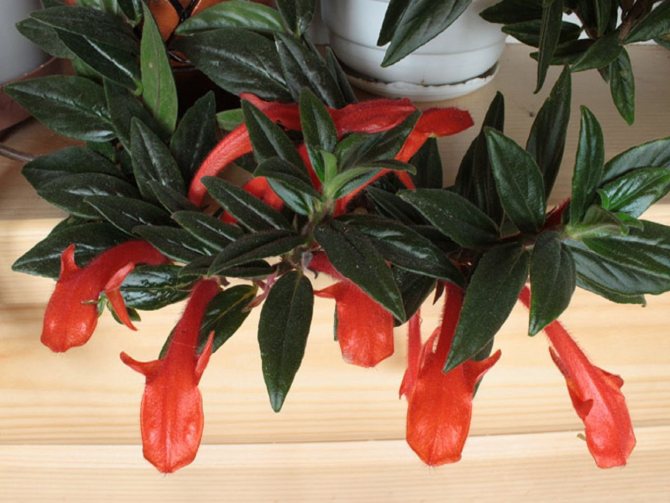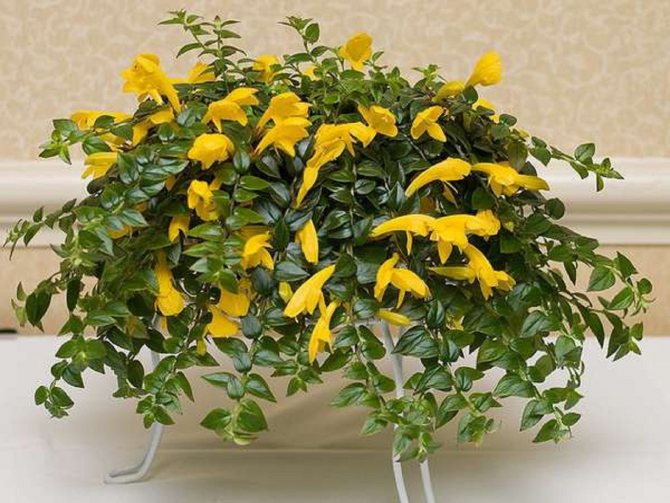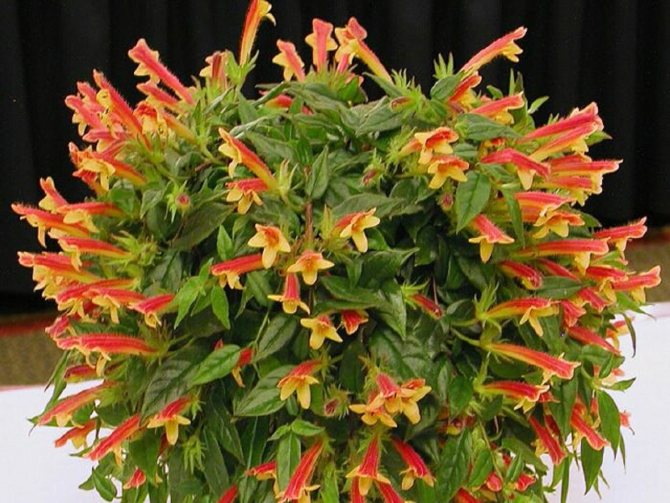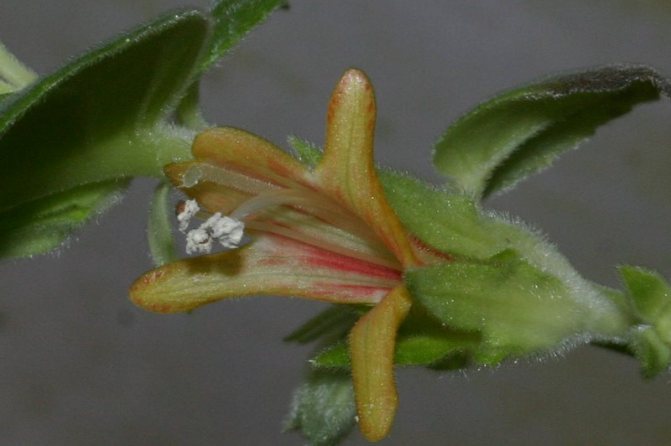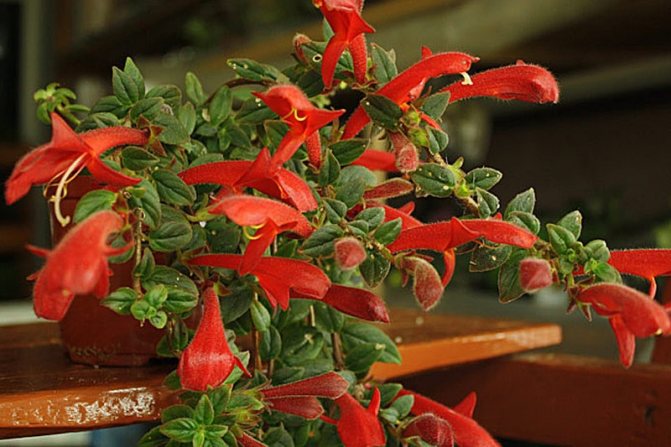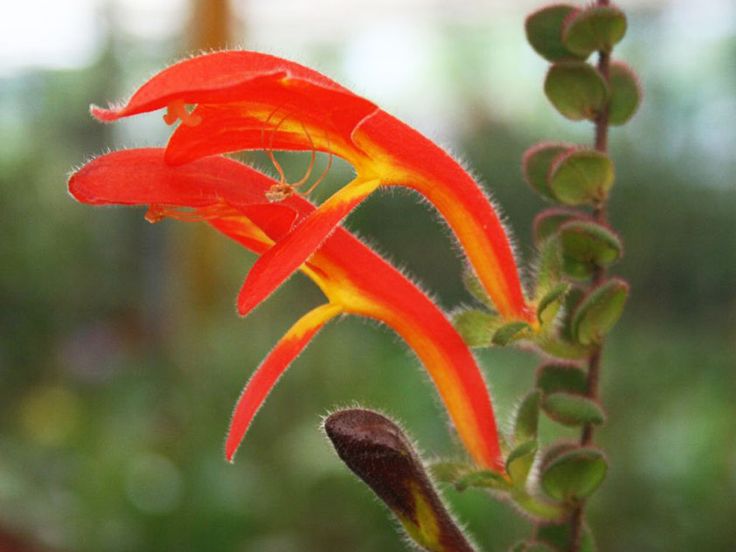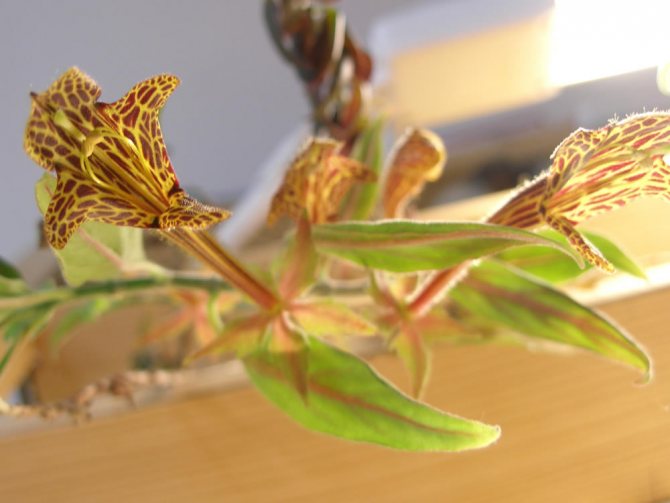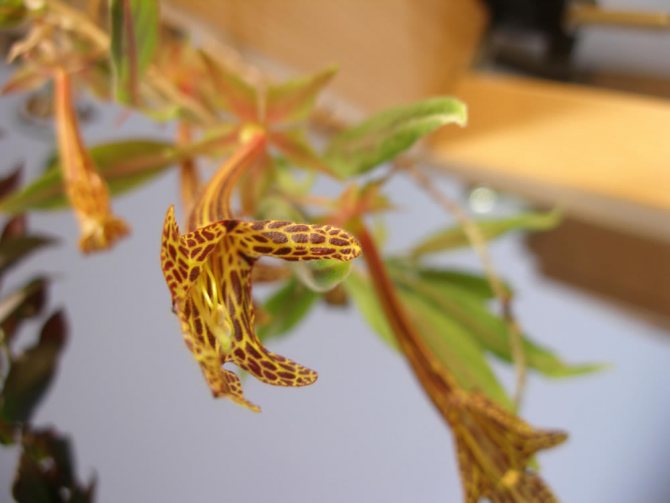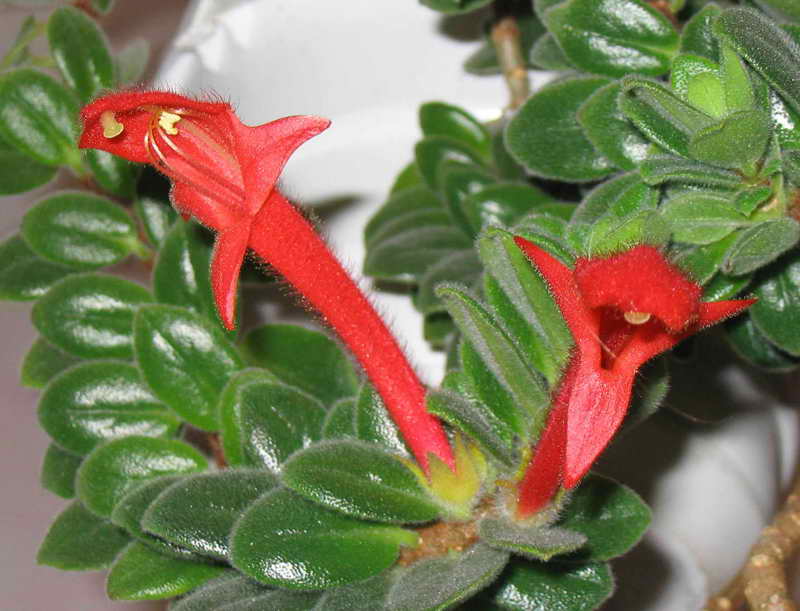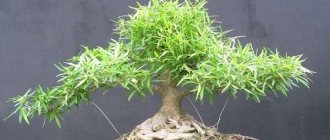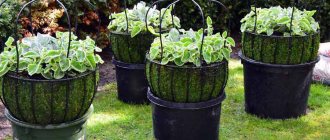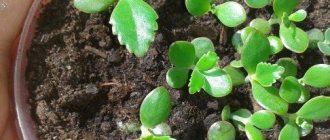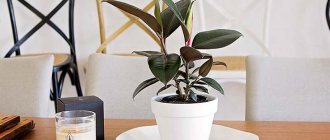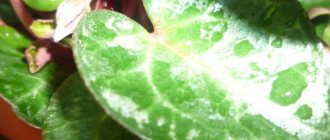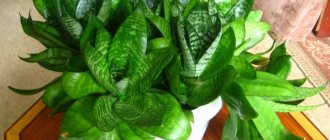Columnea is a gentle ampelous plant with pubescent shoots and bright flowers. For the shape of the bud, the columnea is often called the "goldfish". This plant is native to Latin America, where it forms beautiful thickets in light tropical forests. The kolumney belongs to the Gesneriev family and can boast of an unpretentious character.
Columney - a room guest from South America
For a long time, Columbians were considered collector's plants, as amateur growers believed they were very difficult to grow at home. The spread of Columnea began in the 1950s, when two botanists, Robert Lee and Harold Moore, Jr., created a series of hybrids that were easy enough to grow in captivity. The pot sellers were very impressed and the columnea gained its well-deserved fame.
Columbians naturally inhabit the tropical regions of Mexico, Bolivia and northern Brazil. Exotic plants were introduced to Europe in the middle of the 18th century and named by Carl Linnaeus after the Italian botanist Fabio Colonna.
Without a doubt, the kolumnea has many qualities to recommend it as an interior decoration. The genus Columney of the Gesneriaceae family, to which the flower belongs, includes about 200 species of epiphytic grasses and shrubs. Tubular flowers, painted in different shades of orange, yellow or red, outwardly resemble a bright fish, due to which the columbine is popularly nicknamed "the flying goldfish" and "dancing dolphin".
In the tropics, columneans grow like epiphytes on rotten tree trunks or settle in crevices of boulders. Frequent rainfall provides the roots with a constant supply of moisture, and the stones serve as excellent drainage, which ensures that there is no stagnant water. The plant lays flower buds in the fall. During this period, columneans undergo a significant decrease in temperatures (the difference between day and night is about 10 degrees). If you provide the flower with suitable conditions that resemble natural, then it will become an excellent decoration for your home.
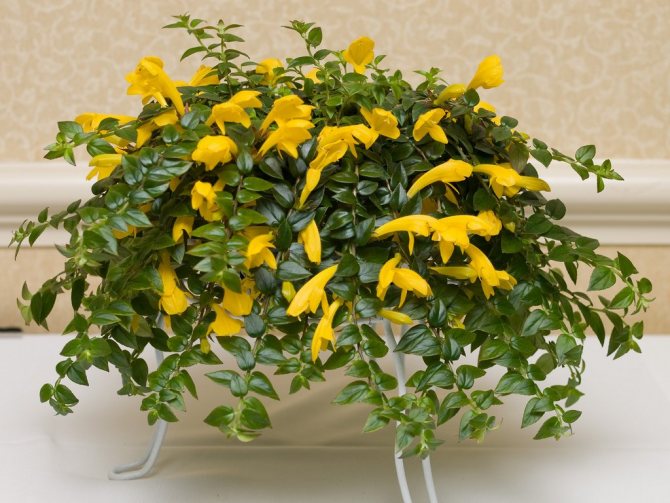
Blooming columnea is a spectacular plant that can decorate any interior.
Very small, leathery and shiny leaves of the "flying goldfish" are located on short petioles. And also there are specimens with soft and slightly pubescent leaf blades. Their shape is slightly elongated, and their color varies from dark green to purple.
Exotic flowers are very interesting. They are tubular and colored in different shades of fiery red, yellow, salmon or orange. The buds are collected in small inflorescences or are located singly in the axils of tiny leaf blades. In indoor conditions, the columnea blooms both in summer and in winter. As already mentioned, the flowering of the "flying goldfish" is quite long and abundant. At the end of this period, fruits are formed on the plant - white berries.


Columnea fruits are white berries
Columnea species and varieties suitable for growing in the room
The genus Columbus includes plants of about 200 species. Only a few of them are grown as indoor:
- Columnea is small-leaved. It is an epiphyte, a semi-shrub with thin and fragile shoots and single flowers.Several varieties have been bred by breeders, one of the brightest representatives of which is the Carnival Columbus (C. Carnival) with small leaves and bright flowers, painted yellow with a red border.
- Columbus gloriosa. Long shoots (up to 70 cm long) with soft foliage are colored in different shades from light green to dark burgundy. Large flowers of gloriosa are colored orange-red with a yellow throat and are covered with fine hairs of a red hue.
- Columney pubescent. It is an impressive plant, usually producing its unusual flowers during the winter. The species is endemic to Panama and Costa Rica. The maximum shoot length is 90 cm. The leaves are velvety, dark green in color and ovoid. The tubular flowers are colored in different shades from salmon to red-orange.
- Columbus of Cus. It is an ampelous hybrid. The flowers are quite large (12 cm in size), orange-red hue. The leaf blades are shiny, leathery.
- Columnea is sharp. A distinctive feature of the species is that the shoots of the plant are colored brown, and the calyx of purple flowers is brownish-purple.
- Columbus Banks. One of the most popular plant species. It has weakly pubescent leaves and thick, sparsely branching shoots. Orange-red buds resemble flames.
- Columbus Allen. A distinctive feature of the species are purple flowers 7 cm in size, located in the axils of the leaf blades of a dark green color. Shoots are thin and long.
- Columnea Vedrarskaya. Unlike other species, Vedrarskaya shoots are thick. Large (compared to other columneas) leaves are colored dark green on one side and burgundy on the other. The flowers have a deep red hue with yellow blotches.
- Columbus Krakatoa. Ampel plant. The stems are drooping, the small leaves are colored dark green. Flowers are medium-sized (5-7 cm in length), red in color.
- Columnea is blood-red. A semi-shrub whose shoots are creeping. Leaves, rough to the touch, have an oblong shape, slightly pointed towards the top. A distinctive feature of the species is that on the back side of the leaf blades have red spots. Intense dark red buds are arranged in several pieces in the axils.
- Columbus Shida. The plant is the largest of all species diversity. Smooth and thick shoots grow up to 1.5 meters in length. Large leaves are colored red on the back. The flowers are pale yellow with red dots and brownish touches.
- Columbus Argut. The red flowers are decorated with yellow strokes along the edge of the petals. Small leaves (1.5–2 cm in length) have a pointed shape. The plant is ampelous, its stems hang down, forming a charming "waterfall".
- Columbus Hirsut. The flowers of this variety have an unusual star-shaped shape with five petals. The buds are colored bright orange with a yellow center. The stem is covered with red villi.
- Columbus Saturn. Large flowers have a long orange-red tube and a wide hood, along the edges of the petals are decorated with contrasting yellow spots. Leaf blades are dark green with reddish edges.
Columnea small-leaved, gloriosa and other species in the photo


A distinctive feature of the species are flowers 7 cm in size, located in the axils


Columnea Carnava has yellow flowers with red edging


A distinctive feature of the species is that the shoots of the plant are colored brown
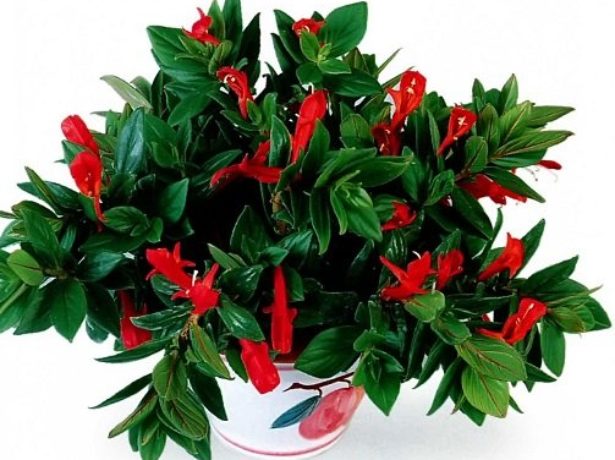

On the back side, the leaf blades of blood-red columnea have red spots.


Long shoots of Columnea Gloriosa are colored in different shades from light green to dark burgundy


Columnea small-leaved is a shrub with thin and fragile shoots and single flowers


Columbia Banks has weakly pubescent leaves and thick, little branching shoots
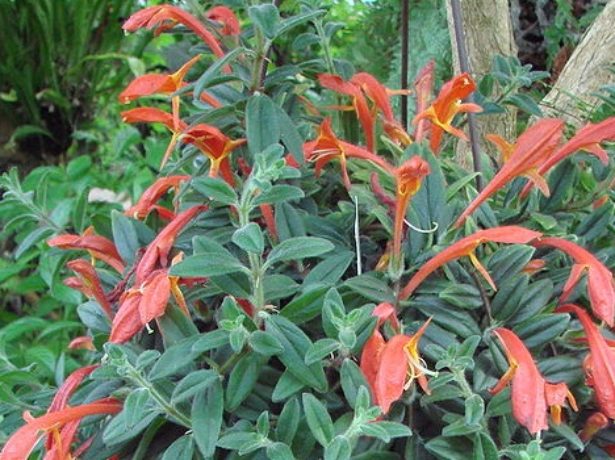

The tubular flowers of the pubescent columnea are colored in different shades from orange to red-orange


Columnea Shida flowers are pale yellow with red dots and brownish strokes
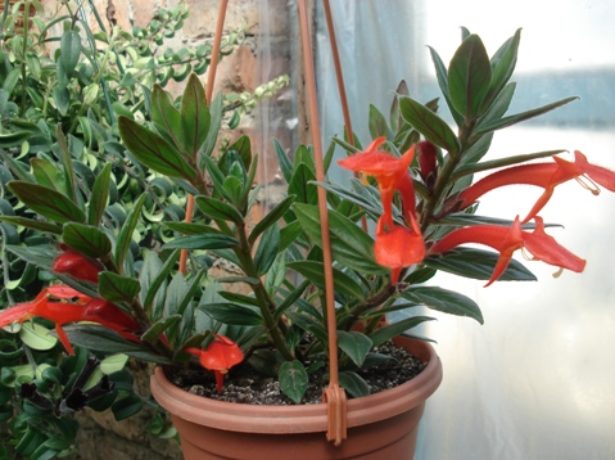

Stems of kolumnea Krakatoa drooping, small leaves are painted in dark green
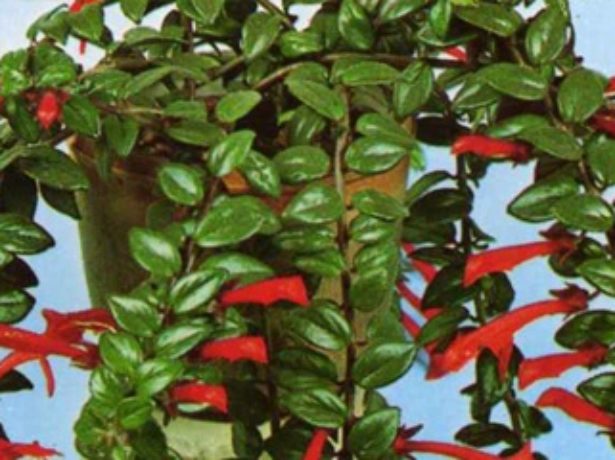

Columnea cusaya is an ampelous hybrid with large orange-red flowers


At the edges, the petals of the Saturn variety are decorated with yellow strokes
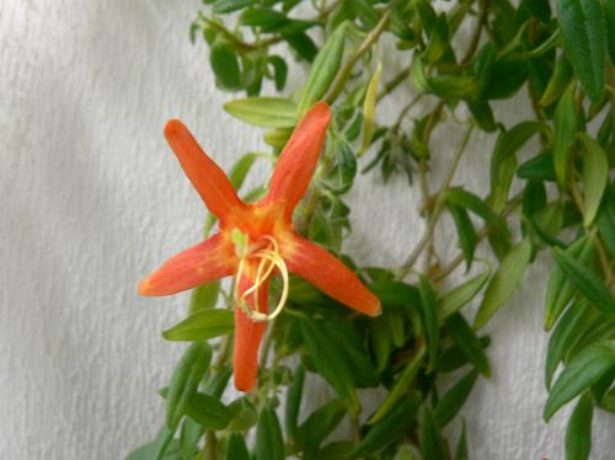

The flowers of the kolumnea Hirsuta have an unusual star-shaped shape.
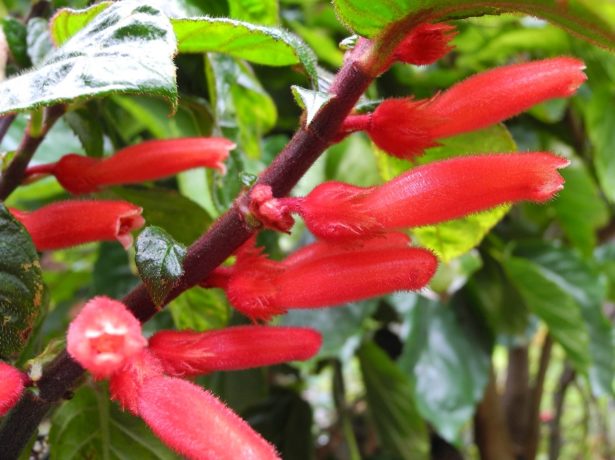

The red flowers of the Argut columnea are decorated with yellow strokes along the edge of the petals
Is it possible to grow it in our city apartment or private house?
Why not? Many people do it, so you have every chance of succeeding.
- Indoor temperature... In the summer, the plant begins an active phase of life and give it 18-20 degrees. In late autumn and winter, the columbine is in hibernation, so transfer it to a closed balcony, where it will be about 10 degrees. She will peacefully exist there with minimal watering, laying buds for the next season.
- Shine... Here, as with most decorative colors: the lighting should be bright, but the sun's rays should not be direct, but diffused. So in the heat it will be useful to shade the flower. She does not need to make an umbrella - choose a place for the flower on the windowsill under a thick mosquito net and see if yellow or brown spots appear on the leaves (this is what sun flower burns look like).
- Watering... There should be no lime in the water. Therefore, it is very, very desirable to water this flower with filtered water. This should be done simply - more in summer, less in winter, as the soil dries up. And of course, the pot should be with holes at the bottom - from here everything that is superfluous will flow out into the pan (immediately drain everything so that your pet does not draw water back with the roots - what has flowed out is not needed).
- Air humidity... This is super important. If the air is dry, the capricious will generally refuse to bloom, and will lose some of the leaves. Spray kolumneya always, and more often in summer.
- Is it obligatory to feed her? To be honest - no, this plant does well without additional fertilizing. However, when it gets ready to bloom (it will throw out buds for flowering), give your pet a mineral fertilizer with phosphorus and potassium. You can buy a standard pet flower feed, but dilute it loosely - half the amount printed on the bag.
- Parasites... This plant is afraid of spider mites, scale insects, aphids, thrips and whiteflies. Therefore, from time to time arrange a "sanitation", carefully examining the leaves of the flower from both sides, especially after bringing new flowerpots into the house. Although, of course, if you look after the flower well and do not forget about the spraying that he likes so much, no pests will cling to it.
- Diseases... If the plant is constantly flooded, gray rot can settle in the roots. Sore roots need to be removed, the cut should be wiped with a crushed tablet of an activated corner, the flower should be transplanted (the soil should be completely changed) and, just in case, treat your pet with fungicides. If things are very bad, cut more cuttings from the flower for propagation - it itself may not survive.
- What else can harm more? Three things: stagnant moisture (which every self-respecting home flower is generally afraid of), lime, hard (not settled, not filtered) water and dry air.
Columnea transplant


This "procedure" is done after the end of flowering. But first, cut off any excess leaves.
In what soil should it be planted? Different will do, the main thing is that there is not a drop of lime in them.
Good example:
- 1 share of deciduous land,
- 1 share of sod,
- 0.5 share of peat,
- 0.25 share of chopped sphagnum, coal, sand.
Put drainage underneath - for example, expanded clay. You can't do without drainage!
In this video you can see the transplant with your own eyes, as well as hear a lively opinion about this procedure of an experienced "Columnist":
How can this plant be propagated?


By cuttings! The twigs can be cut, for example, after the plant has faded, when you will do the pre-planting pruning. Cut them off at least 10, or even 15 cm.
It is good to plant cuttings in mid-spring. Several branches can be placed in a pot at once, so the flowerpot will turn out to be even more magnificent and luxurious.
For the first planting of cuttings, mix peat and sand in equal parts.
Plant the cuttings, make a "greenhouse" (you can tinker with the film, but the easiest way is to just cover the pot with a suitable size jar or glass transparent saucepan for the microwave).
The babies will take root for about a month.
A good example of the propagation of this flower by cuttings is in a step-by-step video tutorial:
Conditions required for indoor columbia - table
| Season | Temperature | Humidity | Lighting |
| Spring Summer | + 20-27 ° С | High humidity required. This requires regular spraying with water at room temperature or slightly warmer (up to 30 ° C). An excellent option would be to locate the flower next to an indoor fountain or aquarium. | Light is needed bright, but diffused. It is better to place it on a window of western or eastern orientation. In this case, the flower must be positioned so that the light falls on it from all sides. |
| Autumn winter | In October and November, the columnea lays flower buds, while the process should take place at a lower temperature. During the day it should be + 15–18 ° С, and at night - + 8–12 ° С. In winter, the temperature of keeping the "flying goldfish" should be + 15–17 ° С. | Spraying once a week. If the plant is in bloom, water droplets should be avoided. | Additional illumination with a phytolamp is required, daylight hours should be about 12 hours. |
Growing not on a windowsill
Columnians are plants that prefer natural light. Of course, supplementary lighting is also salutary for them in winter, but they should receive the main amount of light from the sun.
Therefore, when choosing a place for a columnist, you should immediately refuse to introduce it into the interior. Columnea grows well on light windows, in secluded places without drafts. An eastern, western or southern window sill (with a diffusing screen) will help to avoid mistakes.
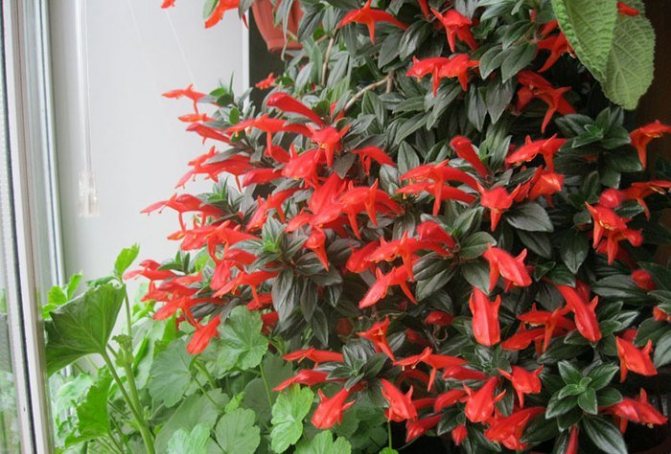

Columnians are plants that prefer natural light. <>
Features of planting "goldfish"
The composition of the potting mix
Column requires nutritious soil. You can compose it from:
- leaf humus (1 part);
- turf land (2 parts);
- compost (0.5 parts);
- small sawdust and pieces of sphagnum moss (0.5 parts).
Other variations in the composition of the soil are also possible, for example, compost can be replaced with high-moor peat, and vermiculite can be added for greater looseness.


Columnea substrate requires nutritious
Ready-made mixtures are also suitable for a flower, for example, soil for Saintpaulias, it develops well even in a universal substrate for flowering flowers.
Choosing a flower pot
The stems of the plant are creeping or drooping, therefore, it is recommended to grow the kolumnea as an ampelous plant in a hanging planter or in a flowerpot with a leg. The pot is required wide, but shallow. A small bowl is perfect. For subsequent transplants, select a capacity 2-3 cm larger than the previous one.


To plant a columnea, a wide dish is required.
Flower transplant
The shoots of the columnea stretch out very quickly, the leaves after the end of flowering begin to fall off and the stems become bare. Therefore, after the plant has bloomed, it is recommended to transplant it, combining this procedure with the rejuvenation of the bush. They do it like this:
- Drainage is laid at the bottom; it can be made from expanded clay or other small stones.
- The soil is poured into the pot, not reaching 1-2 cm to the edge.
- All shoots are shortened, leaving stumps 10-15 cm long (the resulting cuttings can be used for propagation).
- The plant is taken out of the old pot, shaken off the soil from the roots and washed under a stream of warm water.
- The roots are examined and damaged or rotten ones removed. All slices are treated with brilliant green.
- Holes are made along the edge of the bowl, shoots are placed in them and covered with soil. It is recommended to plant several plants in one bowl. So the kolumnea will grow into a lush bush.
- The soil is moistened.
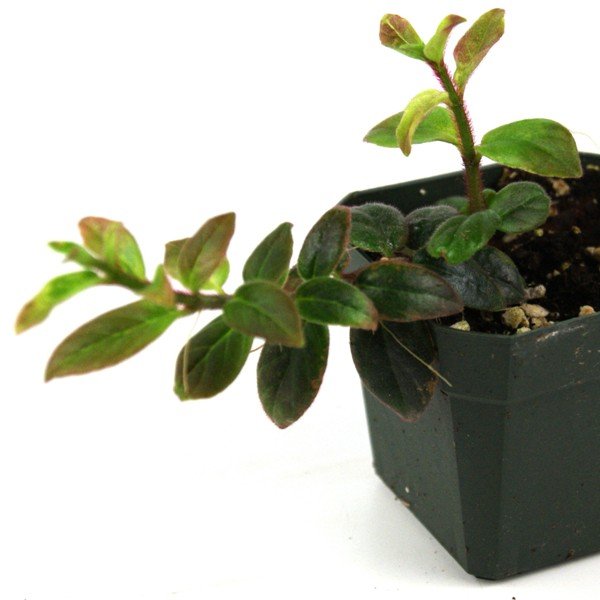

It is recommended to plant several seedlings in one container, so the bush will be more magnificent
After purchase, it is advisable to transplant the flower into a nutritious soil. This can be done at any time of the year, 2-3 weeks after you brought the flower home, as it takes some time to acclimatize.
Do we need a columier support
When the stems begin to grow, they can be tied to pegs so that roots do not form on the shoots lying on the ground. A special bamboo support is best suited for this purpose. When the shoots grow up to 20-30 cm, the need for a garter disappears and the shoots can be allowed to hang over the walls of the pots.
Watering too often
Columnea loves moderately "fresh" soil. It cannot stand the complete drying out of the substrate, but average humidity, which is comfortable for other plants, with a slight drying out of only the upper layer of the substrate, is not the best option.
Achieve light constant humidity by frequent, but not abundant watering. Instead of more rare procedures, it is better to water the columnea with a small portion of water, but every 3-4 days. It is better to check the moisture content of the substrate regularly, it is convenient to use special indicators for this.
Columnea care
If the plant is provided with all the necessary conditions, then caring for it is reduced to watering and periodic feeding.
Watering nuances
Water for irrigation needs settled water. To do this, it is taken from the tap into a vessel and allowed to settle for a day, while the lid is not covered so that all harmful substances evaporate. The optimum moisture temperature for irrigation should correspond to room temperature, but it is possible to use a warmer one (2-3 degrees higher). Please note that the maximum water temperature for irrigation of the columnea is + 30 ° C.
The soil in the bowl with the columnea should always be moist, but not wet.
Watering should be carried out only after the soil in the pot dries up. Columnea does not tolerate stagnant moisture, as a result of which the roots quickly rot in the plant and you can lose it. Also, overdrying of the soil should not be allowed, as this can lead to death. In winter, the number of waterings is reduced to once a week.
How to make top dressing
During the period of active growth, feeding should be done every 10-14 days. Liquid form preparations for flowering plants are best suited for this. "Kemira Lux" or "Fertika" will perfectly cope with this task. However, there is a peculiarity. The solution for feeding columnea should be diluted in a concentration 2 times less than indicated in the instructions, since a large amount of fertilizer in the soil can lead to excessive growth of the vegetative mass to the detriment of flowering.
In the winter period, top dressing is also necessary, but their frequency should be 1 time per month.
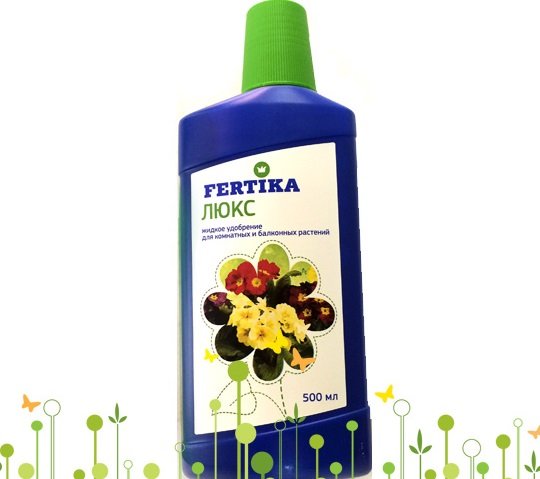

Liquid fertilizer is suitable for feeding columnea
Why kolumnea does not bloom and how to make a plant release buds
Columnea ceases to bloom with a lack of moisture. As soon as you start spraying the plant and place any humidifier next to the pot (a tray with wet sphagnum moss, pebbles or expanded clay), the columbus will release buds. When flowers appear, the plant should not be turned or transferred to another place, since the capricious can throw off the buds or stop releasing new ones.
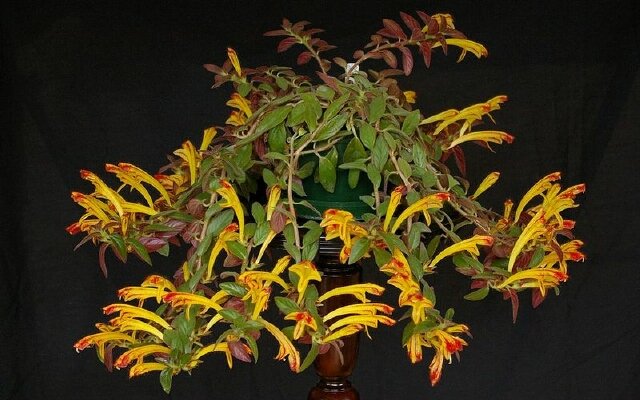

Columnea blooms for a long time and profusely, if you create the necessary conditions for this
So, to make a plant bloom, you need to:
- Provide adequate lighting. The flower needs bright, but diffused light, while it must be illuminated from all sides.
- Arrange high humidity.
- Avoid drafts and do not move the flower to another place.
Do we need a more columned period of rest
As such, the plant does not have a dormant period, but the flower needs special conditions with the onset of autumn. In order for the kolumnea to lay flower buds, it is required to provide it with a difference between day and night temperatures. This can be achieved by placing the pot close to the glass.
Plant formation
In order for the columnea to have a decorative look, 3-5 cuttings are planted in one flower pot. Immediately after planting, they are pinched, which stimulates the formation of side shoots.
In winter, the stems are usually stretched and bare, as a result of which the flower does not look very presentable, therefore it is recommended to cut off the shoots of such a plant in spring, leaving hemp about 5 cm in size.This procedure will allow the plant to grow a lush bush.
A Practical Guide to Caring for Columnae - Video
Consequences of mistakes made when caring for a columnea, and what to do to correct the situation - table
| What does the plant look like? | What is the reason? | How to fix the situation? |
| The leaves turn yellow, their tips are bent inward, then the leaf blades fall off. |
|
|
| The foliage turns yellow and falls off. | excessive or, conversely, insufficient watering | |
| Spots form on the leaves. | watering with cold water | |
| The leaf blades wilt and fall off. | insufficient lighting | |
| Withering of the tops of the shoots. | dry soil during hot periods |
Rest period too long
Columnea is a special plant and is "fast" in everything. If many indoor crops need several months of preparation for flowering, then the columnea should "rest" for only a month. A dormant period in the cool or at least in temperatures lowered by several degrees for 4 weeks at 16 degrees is an achievable goal even in apartments, because the plant can always be placed on the coolest window close to the glass.
If there is simply no cool alternative to the place of detention, it is enough to increase the humidity of the air to compensate.
Pests and diseases that threaten colum - table
| Disease / pest | Signs | How to get rid of |
| Gray rot | A grayish downy mildew covers parts of the plant. |
|
| Whitefly | Small whitish flying insects appear, outwardly resembling tiny white moths. They usually stick to the back of the leaf blade. |
|
| Spider mite |
|
|
Diseases and pests typical for columnea - photo gallery


Gray fluffy mold covers any part of the plant: stems, leaves or buds


Whitefly lays eggs on the underside of a leaf


Treatment with insecticidal preparations will help get rid of spider mites
Description of the plant
Columnea is a perennial herb with a fibrous root system. In their natural environment, columneans are epiphytes or semi-epiphytes and are located in the folds of the bark of trees. Young shoots are directed upwards, but as they increase in size, they begin to droop. Fleshy fragile vines can reach a length of 7-10 cm. They are densely covered with small petioled leaves. The heart-shaped or ovoid leaf blade has a glossy surface, smooth edges and a pointed tip. Branches and petioles often have dense whitish pubescence. The length of the leaves is 2-10 cm.
Flowering occurs in winter and early spring, when summer begins in the southern hemisphere. Single tubular flowers are formed in the leaf axils of the central part of the shoot. Their petals are pink, terracotta, orange or yellow. The two-lipped buds vaguely resemble orchid flowers. Their length can reach 4-6 cm.
How to propagate a columnea
Reproduction of columnea is recommended in the spring. This is done in two ways: by sowing seeds or by rooting cuttings.
Rooting cuttings
This method is the most affordable for amateur flower growers. Columnea cuttings root very well and grow green mass very quickly. Cuttings are carried out in early spring. They do it as follows:
- Cut apical cuttings about 5 cm long each.
- All leaves are removed from the bottom side, leaving 2 pairs on the crown.


Columnea take apical cuttings for reproduction.
- The cut is powdered with Kornevin and the cuttings are placed in a glass with settled water.
- The planting material grows roots very quickly, therefore, after 2-3 weeks, the rooted parts can be planted in a permanent place.
- They take a wide dish, put drainage on the bottom, pour prepared soil and moisten it.
- Cuttings are planted in several pieces, placing them along the edge of the pot.
- The container is placed in a bright place, but in the first week after planting, young plants are shaded from bright sunlight.


In the first week after planting, shade young plants from bright sunlight
Growing from seeds
This method is very time consuming and requires certain skills from the grower. Usually, breeders use this method to multiply especially valuable varieties and obtain new hybrids. Although the columbus at home can set fruits, she needs to be helped in this by carrying out artificial pollination of flowers. To do this, a clean brush with a soft bristle is carried over the stamens and the pollen is transferred to the flower of another plant. Columbians will not be able to self-pollinate (in nature, hummingbirds and moths help the pollination process).
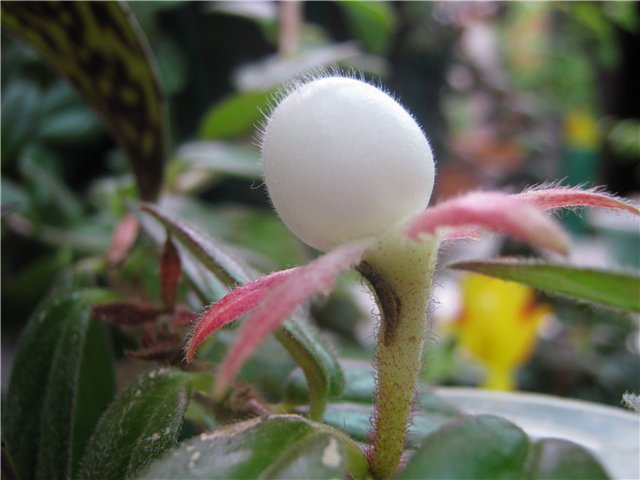

Inside the berry are seeds that can be used for propagation.
After the end of flowering, the pollinated flowers set fruit. These are white berries. When they are ripe (turn white and become a little soft), you can use the seeds for planting. To do this, cut the fruit in half and carefully remove the pulp, placing it on a sheet of paper. Then it is smeared over the surface and left to dry for several days. After that, the planting material can be used for sowing.
Seeds are spread over the surface of loose soil, based on peat. Moisten and cover with a plastic bag. As soon as shoots appear, the shelter can be removed. When the seedlings grow up to 1–2 cm, they must be cut into separate containers and kept in conditions of high humidity, placing a pallet with wet expanded clay next to the plants.
Care for tiny seedlings is required especially careful, since they quickly die from a lack of moisture and from its stagnation in the ground. It is necessary to monitor the condition of the soil, avoiding overdrying of the earth and excessive moisture.
Universal primer
To create an ideal light humidity for a columnea is possible only by choosing the right substrate. Yes, and the roots of a plant can develop normally only in high-quality, loose, humic, non-compacted and nutritious soil. Universal soil is not the best option.
For columbus, a soil mixture for the Gesnerievs and soils for ampelous plants with weakly acidic reactions, in which leafy land dominates, are more suitable. Self-applied loosening additives - perlite, vermiculite, coarse sand - will also not be superfluous. As well as a very high one - 1/3 of the height of the pot - a drainage layer.
Important! Do not transplant columnei unnecessarily.
Reviews of flower growers about columnee
I received as a gift for ordering a cutting of this plant in an online store, where I bought Achimenes last winter. An unrooted cut of a varietal columnea 10 cm long cost about 200 rubles (now more expensive). I just rooted the stalk in a glass of water; in a warm, light place, the roots appear very quickly. Column grows well, stems are thick, about 5 mm in diameter, tough, long, reluctant to bush. Last year, I did not wait for flowering, this spring I cut it off and, finally, my beauty began to pick up buds and I saw her wonderful flower. All the cut branches gave roots and will be planted in one pot, so that there is a thick "head" of greenery. It grows on my eastern window in a hanging pots in the kitchen, as it loves humid air very much, I do not spray it (I once sprayed it in cloudy weather, but the sun suddenly came out - white spots of burns remained on the leaves, since then I have not sprayed it) I take the usual earth , universal, experts write that columbians cannot tolerate lime either in the ground or in water and recommend watering with filtered water.
Svetlana Yurievna
Actually, I would say that I am not babysitting with her. I was on the balcony at a temperature of 10 grams (outside the window, the balcony is not insulated), I water it with not always filtered water (I don’t always have enough for all flowers), spraying is rarely extremely. I bought 400 rubles through a supplier, came with buds, which have faded safely from me. At the same time, the stalk rooted in the pill is also good. Here on the site I found out that the columbine is a relative of Saintpaulia))) Honestly surprised, except for velvet leaves I do not see anything in common. I recommend that the flower is very beautiful in a hanging planter, especially when it blooms. , is also very original.
Aleksashka87
Columnea is a very beautiful and elegant ampelous plant. It looks great in hanging or wall-mounted planters. Its dark green velvet leaves and blood-red butterfly-like flowers create a unique contrast.
osincevat
Despite the experience of growing indoor plants, I constantly have problems growing columnas. After the roots appear, I plant the cuttings in the finished "violet" soil with the addition of ~ 10% vermiculite and perlite and washed sand. At first, the columnea grows normally and even blooms (C.saturn, C.carnival, etc.), then after a while the growth of leaves slows down, the stem becomes hard and the plant loses leaves in the lower part of the stem. Moreover, the upper part of the plant practically does not take root again, and rickety shoots with small leaves appear in the lower part of the stem. This has happened not once.
Osmanthus1
Columbus turned out to be a difficult plant for me. She is about five years old, every year she successfully grows the buds and threw them off safely. The second year she agreed to bloom.
leedu
Temperature jumps
Columbians love stability. Constant temperature drops both in winter and in summer often lead to the fact that the lower leaves fall off more actively, and the tips of the upper ones lose their decorative effect. Accelerated degeneration is a direct result of drafts, which the columnist cannot stand. The more the same conditions the columnea grows, the better.
The reference point is + 25 ... + 27 degrees in summer and + 18 ... + 20 the rest of the time (except for the rest period at +16 degrees).
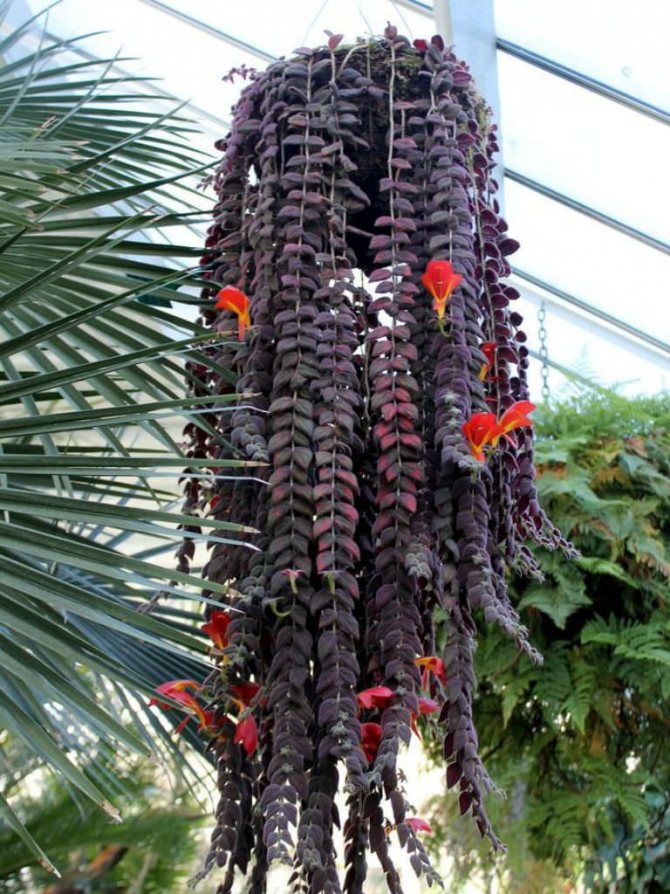

The more the same conditions the columnea grows, the better. <>
Columnea varieties that might interest you
There are almost 200 species of this flower, and almost all of them are wild. True, some columbians nevertheless moved closer to civilization. They can be seen not only on window sills, but also on balconies, terraces, and flower beds.
I will tell you about the most popular varieties. The coloring of their flowers and even leaves may differ. Choose the one you like the most!
Columnea Krakatoa
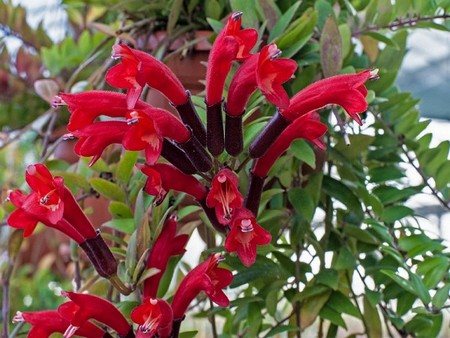

The most popular variety of this plant is at least in the territory of our homeland. This is a hybrid of Column Banks, created specifically for apartments and houses. Interestingly, this variety was named after the volcano - when it erupts, it emits lava of the same color as the petals of the Krakatoa flower. The length of such flowers, by the way, is impressive - they grow up to 12 cm!
Blood red
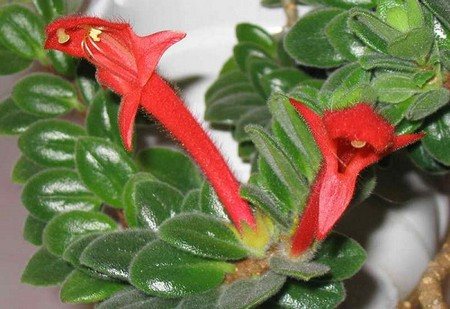

In the wild, it is a mountain flower from the Antilles.
The leaves of this variety are larger than those of other columbus - up to 30 cm.
The pubescent red flowers bloom in groups.
The shoots of the plant are spread over a meter, they are quite hard to the touch.
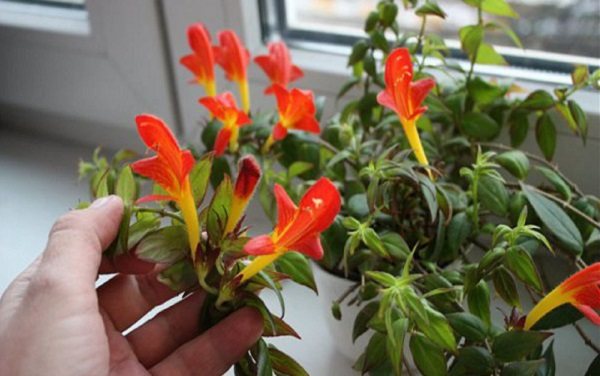

No, it is named not in honor of the Russian female name, but in honor of the researcher, whom we must thank for such an orange-red flower.
The homeland of this variety is Panama, namely the jungle of North America. The plant has small, elongated leaves and large, very noticeable flowers. The shoots of the flower constantly hang from the pot and creep and grow somewhere - such is his nature!
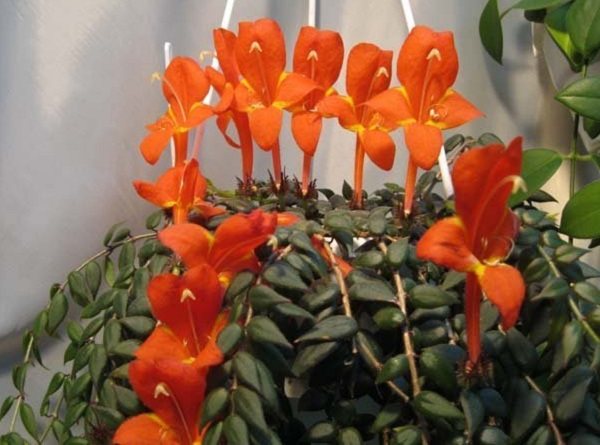

It was found in America - both Central and South.
Flower shoots are also long (up to a meter), dense. Leaves are glossy, reddish below. The flowers are medium in size (about 6 cm), their shade fluctuates between red and orange, in the middle there are yellowish blotches.


Small leaves of this flower have both a fringe and a glossy surface.
But of course, its main advantage is its bright yellow, large flowers. Each is decorated with scarlet edging around the edges.
Pruning
Each time after flowering, the columnea should be cut off. This is necessary to rejuvenate the plant and maintain its spectacular appearance. If the vine is not cut, after a few years it will turn into an untidy bush. Cut off a third or half of the length of the shoots. It is also necessary to remove dried leaves and wilted flowers in a timely manner.
After 5-7 years, it is desirable to grow a new plant from cuttings.
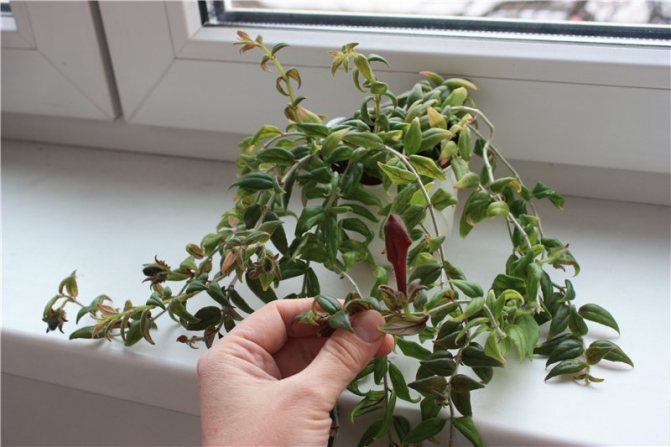

Pruning Columnea
Useful properties of columnea
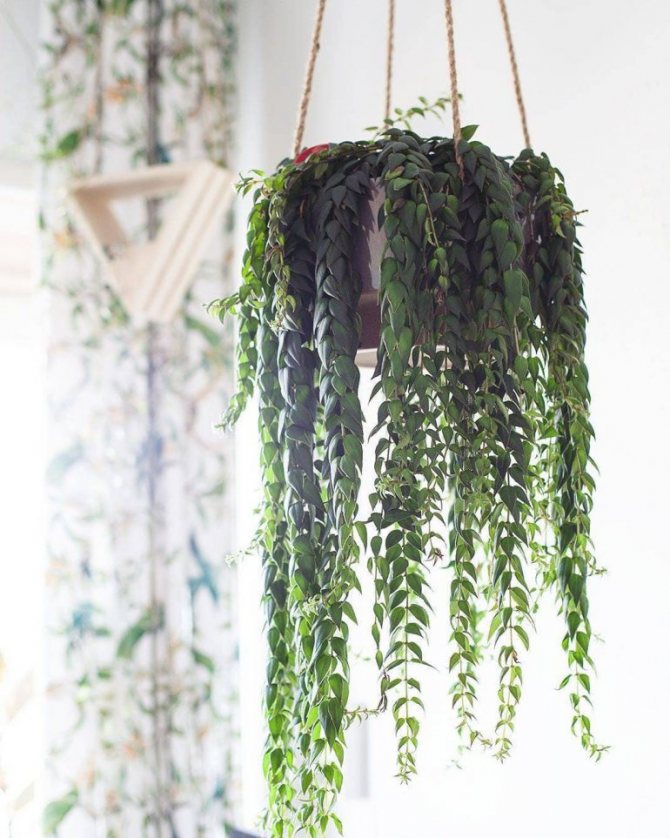

Columnea releases biologically active substances that purify the air in the room. A healthy air environment has a beneficial effect on the body, increases efficiency and stress resistance. An original exotic plant decorates the interior. Contemplation of a blooming columnea evokes positive emotions, reduces the level of anxiety.
Getting to know this overseas "personality"
At its core, it is a creeping epiphyte vine. In the wild, the flower lives on trees, and in our houses it plays the role of a rare ampelous plant, that is, this is a good solution for hanging pots.
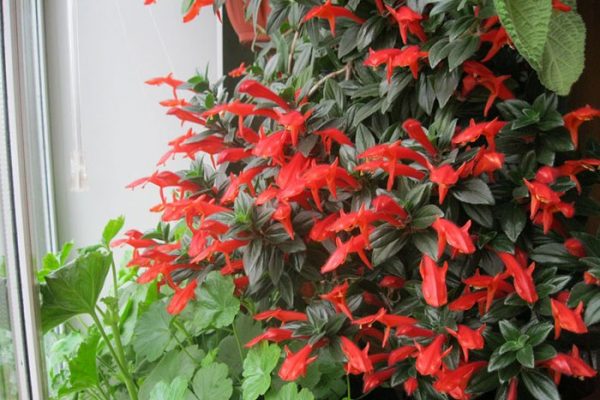

Its close relatives are gloxinia, saintpaulia, coleria and streptocarpus. Many people believe that the columnea is a relative of the orchid, although in fact it is not ... At least in terms of biology. Although flowers really have a lot in common - take at least the same epiphyticity.
Columnea is a plant that will not tolerate neglect of itself. But with proper care, it will bloom throughout the apartment and will become the real pride of its mistress.
Transplanting kolumnea after planting and during the growing season


How to transplant a columnea correctly
The root system of the columnea is fibrous and sensitive to transplantation, so transfer with an earthen lump.Perform the first transplant immediately after purchase, then transplant as the substrate is filled with roots. Transplant in early spring.
Important: When replanting, cut off one third of the roots with a sharp knife every two years to stimulate rejuvenation of the bush. Otherwise, over time, the flower will degenerate.
The transplant tank is medium sized and shallow. At the bottom of the pot, lay a drainage layer consisting of expanded clay, pebbles or pieces of foam (you can mix it).
At the flower shop, you can purchase a versatile substrate. Prepare the soil mixture yourself if desired. You will need 4 parts of sod and leafy soil, 2 parts of peat and 1 part of sand, add a little sand and charcoal.
Difficulty leaving
Experts attribute the columnea to moderately demanding indoor flowers in terms of care. If not properly maintained, it can survive, but its growth will noticeably slow down. Other negative consequences are also possible:
- The appearance of spots on the leaves (watering with insufficiently warm water, spraying in the sun);
- Yellowing, leaf falling (lack of light, insufficient humidity and inappropriate air temperature, excessive drying of the soil in the warm season);
- Twisted leaves (moisture deficiency);
- Rotten stems (excessive watering when kept in the cold);
- Lack of flowering (non-observance of the temperature regime during the formation of buds);
- General wilting (root burn from excess fertilizer).
If the conditions for care are not followed, the column can be struck by:
- spider mites;
- mealybugs (hairy lice);
- whitefly;
- thrips.
Insecticides will help in pest control (Fitoverm, Agravertin, Actellik). Insects must be rinsed off with a directed stream of water before being treated with an insecticidal agent.
Common diseases
Columnians are very resistant to various diseases, but excessively moist soil can contribute to the formation of gray rot. A fluffy layer of mold can cover any organ of the plant. The affected areas are cut and burned. The plant is sprayed with a systemic fungicide (Topsin, Fundazol, Zuparen).
Subject to the simple rules of keeping the columnea, it can bloom anywhere. Biologically active substances secreted by the plant purify the air and have a beneficial effect on the human condition. But beginner florists should opt for the more common types. With insufficient experience of the grower, a plant with pubescent stems and leaves may die.


Columnea is a very beautiful vine, which is related to such rather popular indoor plants as: streptocarpus, coleria, saintpaulia, and gloxinia. But despite all its beauty, for some reason, flower growers did not like her, and you can very rarely meet her in an apartment.
This flower is often referred to as the "room orchid", but it is not related to the orchids themselves. In fact, it is a creeping vine that prefers to live in trees and is an epiphyte. It also belongs to ampelous plants, and can overshadow many other indoor flowers with its beauty and originality. However, caring for her is not so easy, but it is still quite possible to grow her at home.
Reproduction
Columnea can be propagated in two ways: cuttings and seeds. The second method is a rather complicated procedure and is practically not used by amateur flower growers (when propagating by seeds, special greenhouses must be built in which a constant temperature, air humidity and lighting are maintained). Seed propagation is used by professional breeders who are constantly developing new types of columnas.
Learn how to propagate by cuttings: rose, plumeria, chrysanthemum, clematis, crossandra and king geranium.
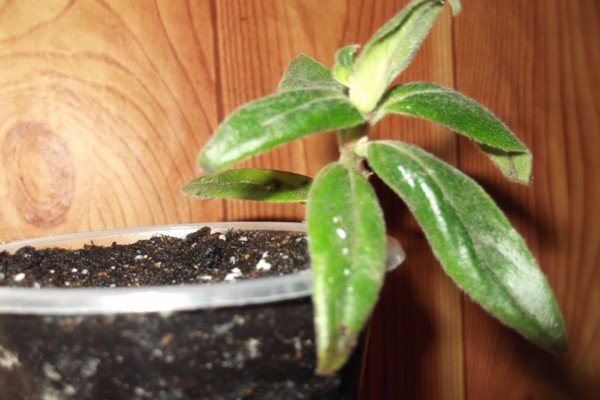

Important! The soil temperature for planting cuttings should be + 20 ... + 25 ° С.
Breeding with cuttings "goldfish" should be started in the middle or end of February. To do this, take the tips of shoots 4-6 cm long, on which there are 3-5 leaves. 3-4 cuttings are planted in five-centimeter containers (you can use cassette containers and plant one cuttings at a time). Seedlings should be watered daily, illuminated and kept at a temperature of + 20 ... + 22 ° C. But young cuttings do not tolerate excessive moisture (it happens that the leaves begin to rot).
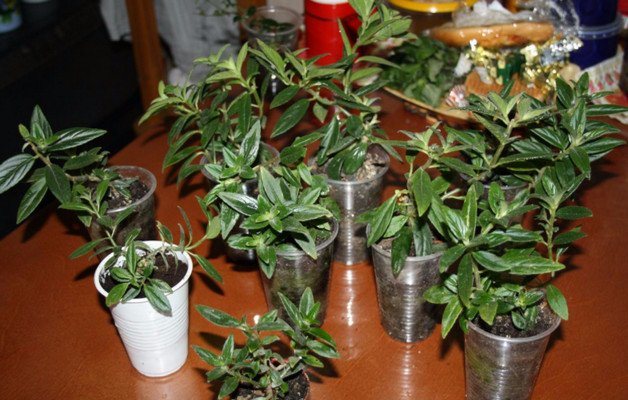

The substrate for cuttings is prepared from three equal parts of humus, river sand and leafy soil. After the young cuttings take root, they need to be transplanted into larger containers. Prepare the substrate in the same way, but add a little more leafy soil. Reproduction of columnea is a rather delicate process, and after the cuttings are planted, special care is needed for them, which implies feeding, watering, lighting, maintaining the temperature regime, etc. Feeding the rooted cuttings should be carried out using complex fertilizers every week for 2 -2.5 months, after which again transplant into a deeper container.
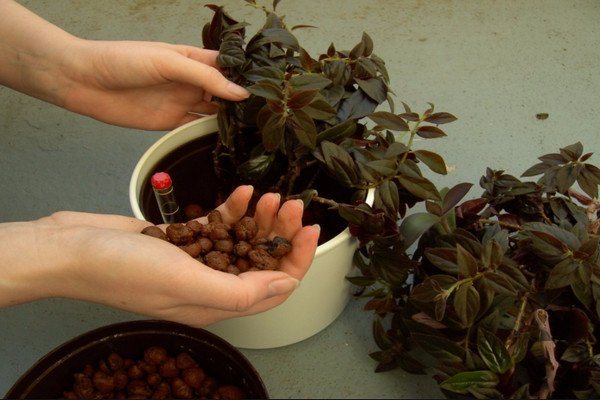

Fertilizer
Feeding the plant can be started in the spring with the appearance of the first buds. Regularity - every 10 days. For this purpose, it is better to use liquid complex fertilizers.
It is important to ensure that there is no lime in the fertilizer.because it has a very negative effect on the growth and development of the columnea. Before fertilizing, the flower must be watered so that there is no root burn.
When the plant fades, the frequency of fertilizing is reduced to 1-2 times a month. Fertilizers are not needed in winter.
Transfer
Columnea should be transplanted as needed, when the roots braid the entire pot, as a rule, once every 1-2 years. The optimal time for transplanting a columnea is after flowering.... The pot should be chosen 2-3 sizes larger than the previous one.
When transplanting, it is necessary to examine the root system. If there are rotten roots, remove them. After transplanting, the plant is pruned to give it the desired shape. This removes damaged and dry shoots.
Conditions
The kolumney does not have any special requirements, but it is necessary to observe some of the subtleties of care.
Attention! Columnea retains its decorative qualities for 6 years, then the flowering decreases, becomes not so abundant, the flowers become smaller.
Temperature
The plant prefers a range of 23 ... 27 ° C. Does not give her discomfort and short-term increase up to +30 ° С.
View this post on Instagram
Publication by Elena Novitskaya (@elflowernov) May 10, 2019 at 9:13 am PDT
Towards the middle of autumn, the columnea is taught to lower the temperature, leaving it on the balcony during the day, and putting it indoors at night.
Important! In winter, it is advisable to keep the columnea until the beginning of spring in a room with a temperature of 16 ... 17 ° C.
Lighting
In the tropical forests of South America, the columnea settles on high tree branches, where there is enough light for it. At home, the flower should be placed on the southeast and southwest windows.
Varieties with glossy leaves need to be shaded, and other plant species prefer diffused lighting..
If you place a flower on the north window, it will grow and stop blooming due to lack of light.
Moisture indicators
Humidity of 50-60% has a beneficial effect on plant development: gas exchange processes in the leaves are improved, nutrition is enhanced.
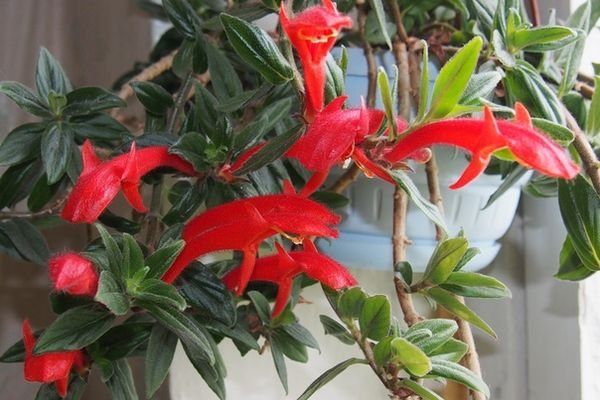

Smooth-leaved varieties it is recommended to spray and wash off the dust from the leaves... For pubescent species, a wet shower and spraying are not suitable; containers with water can be placed next to them to maintain the necessary humidity.
Photo
We recommend watching a useful video on the topic of the article:
Main types
From a botanical point of view, the columnea is not a separate plant, but a genus.The name is common to many types of flowers.
Did you know? About 200 species are considered to be columbians.
All varieties have their own distinctive characteristics, having studied which the florist can choose the most attractive for himself.
.
Below is a list of the most common in our area:
- Allen. The variety is distinguished by its large stems and bright red buds. The foliage has a dark green color.
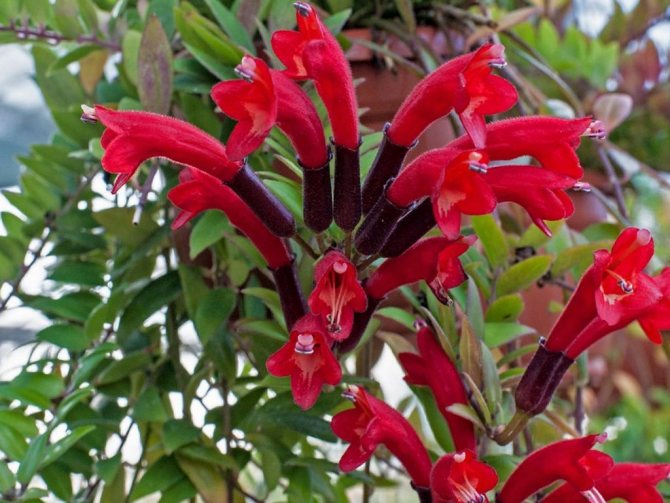

- Banks... The leaves of the plant are light, the flower petals are yellow-orange. The stems grow up to 1 m.
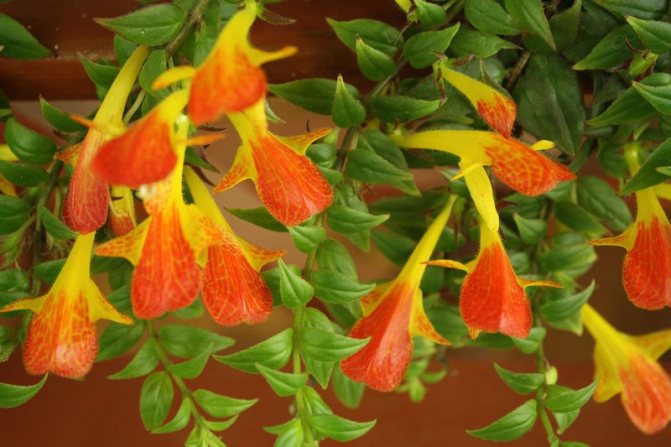

- Carnival. The species has a distinctive feature in the form of small dark leaves with a glossy sheen. The flowers are yellow with red edges.


- Consanguine. On the leaves of the representatives of this variety, there are large blotches of red. The bloom is light yellow.
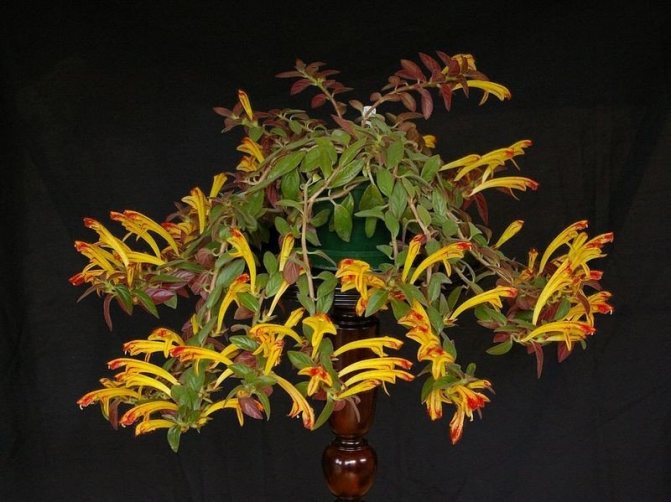

- Krakatoa. Shoots are dotted with dark blotches and grow upward. The buds are red with an orange tint.
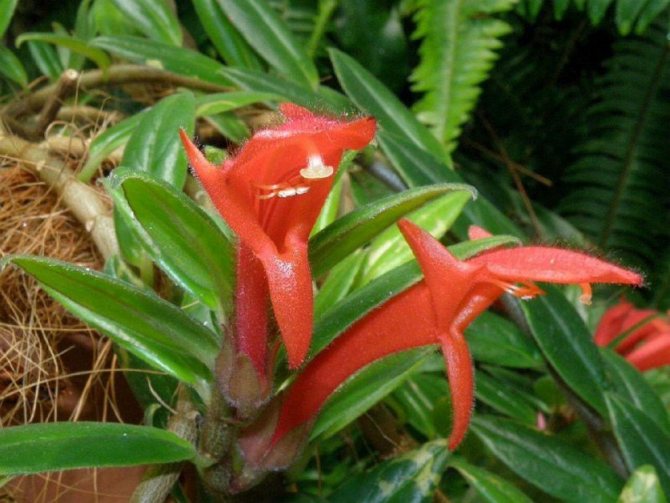

- Blood red. The leaves are covered with scarlet spots. The flowers have a pronounced red color.


- Glorious. The foliage of this variety is dark. Flower petals have a shade close to red-orange.
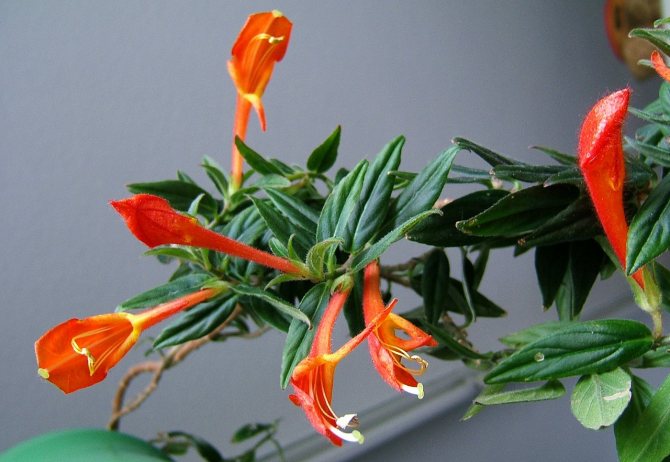

- Shida. The entire green part has a red fluff. The leaves are dark, the flowering is yellow.
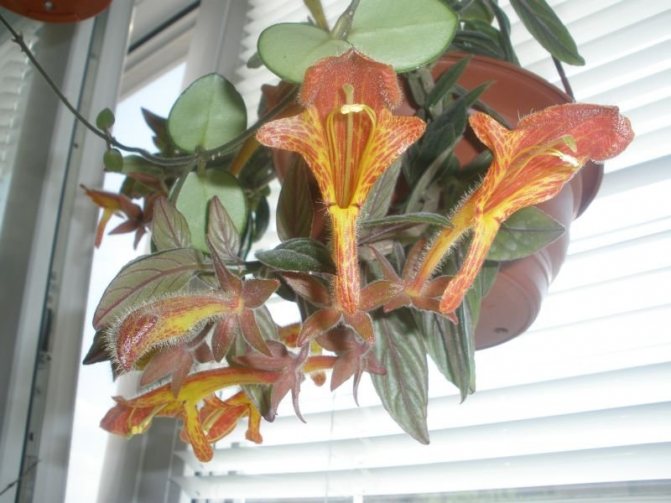

Humidity
Columnea requires high ambient humidity - 70-80%... To achieve this result, you can apply the following methods:
- Place the plant pot away from heating appliances;
- If possible, hang a flower in a planter above the aquarium;
- Use a humidifier;
- Put a pot with a plant in a pallet with wet expanded clay or pebbles;
- Once every 2 weeks, arrange a more warm shower, then let it dry in a warm and dark place. This will additionally prevent the appearance of pests;
- Place containers with water around the flower - evaporating, it will increase the level of humidity.
Temperature regime
The room where the columnea is located should be kept at a temperature of 23-28 ° C. If the room is hotter, then it is necessary to maintain sufficient humidity.
In the cold season, you can stimulate the laying of new flowers. To do this, the plant should be placed in a cool place with a temperature not exceeding 18 ° C.


Column in the house
Columbus: basic information and features of care
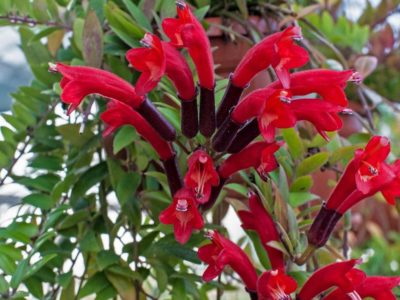

A cascading waterfall of shoots with bizarre flowers is often referred to as one of the varieties of orchids by inexperienced lovers of ornamental plants. But the kolumneya, which is considered difficult to take care of at home, is related to the familiar Usambar violet. In fact, the content of the columnea is not so burdensome. The main thing is to choose the right place for its placement and comply with a number of "requirements" of a tropical beauty.
Diseases
With proper care, the columnea is rarely affected by pests or diseases. However, if the soil is too wet, gray rot may appear. Control measures will be the reduction of watering, fungicide treatment. However, the plant often dies anyway.
Of the pests, under unfavorable conditions of detention, the scale insect, aphid, and spider mite can pose a danger to columnea.
To get rid of unwanted insects, the flower should be treated with soapy water.... If there are a lot of pests, you will have to apply an insecticide, for example, Actellik, Nurrel-D, Fitoverm.

